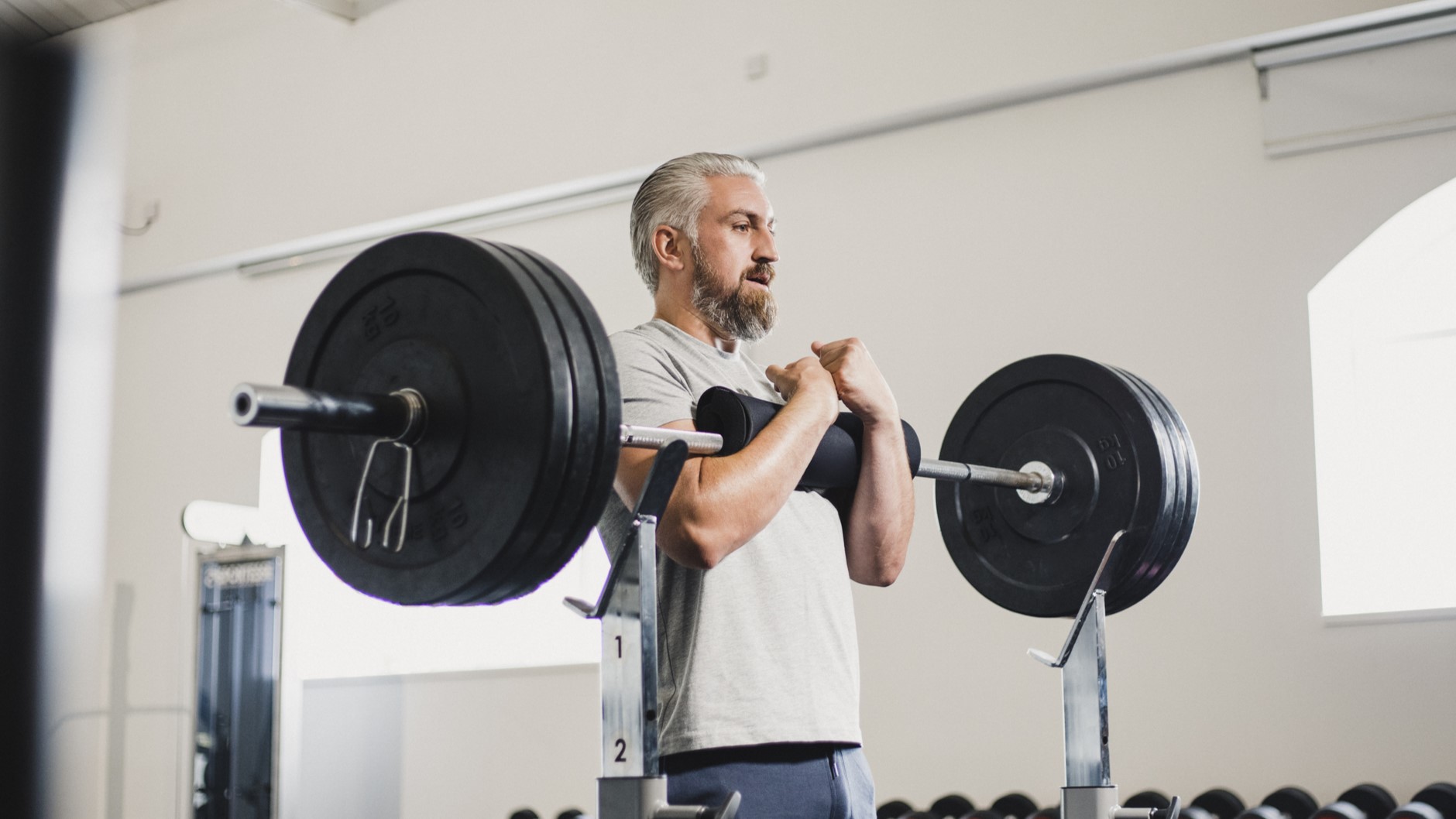
There’s one thing that all fitness fanatics have in common: they’re spoiled for choice when it comes to the types of workouts they can choose from. Whichever body part you’re working on, there’s an endless list of exercises to pick from, all with their own unique variations, and claiming to target different muscles in different ways with varying levels of difficulty and benefits.
For this reason, it’s common for some exercises to gain popularity more so than others, with certain workouts becoming the “flavor of the month” as gym-goers pick up on what others are doing — or they see them on the fitness channels of certain social media platforms.
One such exercise that’s been gaining attention of late is the Zercher squat. Created by world-renowned power lifter Ed Zercher way back in the 1930s, this variation of the traditional squat differs in that the lifter cradles a barbell in the crooks of their elbows as they squat, creating a different movement pattern and challenging the lifter's strength and stability.
Despite being around for ages, the Zercher squat has become a popular exercise among strength athletes, bodybuilders and fitness enthusiasts recently due to its potential benefits in targeting the legs, core and upper body.
While many fitness enthusiasts swear by the Zercher squat's effectiveness, I decided to put it to the test by incorporating the exercise into my daily routine for a week. Can doing this challenge really help improve my strength, physique and overall fitness in just seven days? Let’s find out…
Why Zercher squats?
To get a better idea as to why someone might want to integrate Zercher squats into their workout routine, I spoke with London-based celebrity personal trainer, Pilates instructor and barre specialist Aimee Victoria Long, who detailed a number of benefits the exercise brings.
This, she says, includes core strength, upper body development and posture improvement.
Sign up to get the BEST of Tom's Guide direct to your inbox.
Get instant access to breaking news, the hottest reviews, great deals and helpful tips.
“Zercher squats heavily engage your core muscles due to the front-loaded nature of the exercise, which helps to develop a strong and stable midsection,” explains Long.
“And since holding the barbell in the Zercher position requires your biceps, forearms and upper back to work harder, it leads to increased strength and muscle development in those areas.”
Long adds that the front-loaded position of this exercise is also beneficial, as it encourages an upright posture, which can help correct poor posture habits over time.
“Zercher squats activate multiple muscle groups simultaneously, including your quadriceps, hamstrings, glutes, and calves, making it a highly effective compound exercise for a full body workout,” she says.
It’s advised by most PTs that people with an intermediate level of fitness, like myself, should complete three sets of 10-12 reps of Zercher squats when included in a standard gym workout, with 60-90 seconds of rest in between. Depending on the weight of the barbell involved, this helps build more muscle endurance and strength.
As for beginners, they should do a few less, starting with three sets of 8-10 reps as this allows you to focus on proper form and build a foundation.
If you’re a pro or more advanced lifter, it’s recommended to complete 3-4 sets of 10-12 reps or even heavier with 4-6 reps for extra strength and power.
As for the barbell weight, Long advises choosing a weight that allows you to comfortably complete your sets while still feeling challenged.
Since I’m no newbie to squats, I knew that I should be able to manage around 30 squats (three sets x 10 reps) daily without sustaining injury.
While I was aware that performing regular Zercher squats could help improve posture and work my core and midsection area thanks to them offering a full body workout, the question was: could I achieve noticeable improvements, such as better muscle definition in these areas in just one week?
How to perform a Zercher squat
Before I delve into the results of my week-long Zercher squat challenge, let’s look at how this exercise should be done. Long gives us a detailed step-by-step breakdown:
- Step 1: Start by setting up a barbell in a squat rack at about waist height.
- Step 2: Stand facing the barbell and position yourself so that the bar is in front of you, just above your elbows.
- Step 3: Reach down and grip the barbell with both hands, crossing your arms over each other and securing it against your body.
- Step 4: Step back from the rack and position your feet shoulder-width apart, toes slightly pointing outward.
- Step 5: Engage your core, keep your chest up, and maintain a tall posture throughout the exercise.
- Step 6: Begin the movement by bending at your hips and knees, lowering your body into a squat position. Aim to get your thighs parallel to the ground or slightly below.
- Step 7: Make sure to keep your knees in line with your toes and your weight evenly distributed through your feet.
- Step 8: Pause briefly at the bottom of the squat, then push through your heels to return to the starting position.
I did Zercher squats every day for a week — here’s what happened
So, how did I get on with my week-long Zercher squat challenge? Let me give you the lowdown, day by day.
Day 1
I’m no stranger to a good old squat, but before getting down to business, I knew it’d be a good idea to warm up. I did 20 regular squats without any weight before I got to work on the 30 Zercher squats. I chose a weight of 16kg.
As it was my first day, it proved to be pretty challenging. Holding the barbell in the crooks of my elbows was a little awkward and my upper body felt the strain. My legs and core got a decent workout, but I couldn't do as many reps as I'd hoped. I completed 25 out of the 30 I had planned before heading off to rest my legs in a bath of Epsom salts.
Day 2
The second day saw the arrival of some expected soreness from the previous day, especially in the quads, hamstrings and core. Still, I pushed through. This time I managed to perform the full 30 Zercher squats but lowered the weight to 12kg. While still challenging, I did notice the movement of the exercise felt a little smoother.
Day 3
The DOMS had really set in today, which made another gym day a much less appealing activity than usual. I did feel a tad stronger when performing the squat reps, though. Keeping the weight at 12kg, my arms seemed more at ease in the Zercher squat position, too, and my body was starting to gain a better sense of balance.
Day 4
I was past halfway through and the soreness wasn’t quite as bad — my body had certainly gotten used to the persistent squatting. It also became apparent that my legs and core were growing more resilient to the movement of the exercise — it had become a little easier. I also felt more stable in the squat position so upped the weight to 16kg.
Day 5
While the muscle soreness was still present, it was less of a hindrance and I was feeling stronger in the Zercher squat than ever before. In fact, the exercise felt like a regular part of my daily routine by this point. Was also feeling stronger in my quads, hamstrings, glutes and core.
Day 6
This day seemed to be more of a mental challenge than a physical one. Mostly because I was starting to tire of doing the same exercise every day. I was, however, completing my sets with 16kg with relative ease and the soreness had just about gone. Physically, I felt good.
Day 7
It was the last day of performing 20 Zercher squats and while I felt good for it, I was happy for it to come to an end. My quads and glutes felt much firmer and my core had notably strengthened. My upper body also felt far more stable in the Zercher squat position than it ever had before. I was performing the squats with ease and felt powerful. I was very glad to complete that final rep, though.
So, the big question: what was the overall result — did the challenge result in any visible improvements?
I’ll be honest: since I don’t have much definition in that department to start with, I can’t say that I saw too much of a difference in my overall appearance. My legs and core felt firmer, for sure, and I felt stronger in these regions, too. Perhaps if I continued to integrate this exercise into my workout routine longer term, I might see some increased definition.
On the other hand, I’m more than aware that — when it comes to making changes to the midriff area — nutrition is key. While core-based exercises can help to build and strengthen the core muscles, a calorie deficit is the one thing that can help burn the fat needed to reveal the muscle definition underneath.
So, would I be willing to take on this challenge again? Probably not. While I did reap the rewards of doing such an intense workout every day, it was challenging and not as enjoyable as my gym experiences when I mix things up a bit more.
As a result, I think it would be more beneficial to implement this exercise into my workout routine long-term. Long even advises this herself, stating that while Zercher squats can provide several benefits, it's not typically advised to perform them every day.
“Like any strength training exercise, your muscles need time to recover and adapt,” she says, recommending that gym-goers instead try to include a variety of exercises in their routine while allowing for at least one or two rest days per week to allow for proper recovery.
More from Tom's Guide
Lee Bell is a freelance journalist and copywriter specialising in technology, health and fitness and how the latest innovations are shaking up the lifestyle space. From national newspapers to specialist-interest magazines and digital titles, Lee has written for some of the world’s most respected publications during his 12-plus years as a journalist.

